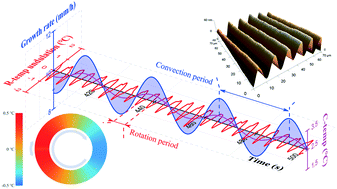In situ visualization of the quasi-periodic crystal growth interface fluctuation by growth interface electromotive force spectrum in a Czochralski system
Abstract
Inhomogeneity and striations stemming from growth interface fluctuation impair the performance of bulk single crystals. Although an enormous number of theoretical and experimental simulations have generalized interface fluctuations, in situ detection at high temperatures of the constantly-changing Czochralski (CZ) system is still unattainable. To solve this issue, we used growth interface electromotive force (GEMF) to reveal interface fluctuations and visualize both the corresponding subtle growth rate and temperature fluctuations in a real CZ system. In addition, GEMF could present the regularity of the coupled melt convection as well as predict a gradient surface morphology. Notably, the visualization of the above phenomena is far beyond the capability of current crystal growth sensors. However, based on the GEMF method, significant evidence to reveal convection instability is achieved. More importantly, the high-precision in situ GEMF feedback could bridge the quasi-periodic interface fluctuation with convection control approaches and serve as visual guidance for optimization of the growth system, which serves to achieve a striation-free high quality crystal boule.



 Please wait while we load your content...
Please wait while we load your content...